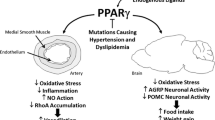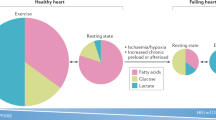Abstract
Peroxisome proliferator-activated receptor-γ (PPARγ) is a member of the nuclear hormone receptor superfamily. It is expressed in adipocytes, immune cells, and cardiovascular cells that include cardiomyocytes, endothelial cells, and smooth muscle cells. PPARγ plays a role in regulating cellular anti-inflammatory responses and is a mediator of insulin sensitization induced by thiazolidinediones, which also can reduce elevated blood pressure both clinically and experimentally. As a result, research regarding the role of PPARγ in blood pressure homeostasis is ongoing. Recent studies have demonstrated that increases or decreases in blood pressure phenotype may be PPARγ-dependent and involve a number of different signaling pathways. Furthermore, studies using PPARγ mutant transgenic and knockout animal models provide further evidence regarding a role for endothelial-cell and vascular smooth muscle-cell PPARγ in blood pressure regulation. However, there is a need for further research regarding PPARγ- mediated mechanisms involved in maintaining physiologic control of blood pressure.
Similar content being viewed by others
References and Recommended Reading
Kliewer SA, Umesono K, Noonan DJ, et al.: Convergence of 9-cis retinoic acid and peroxisome proliferator signalling pathways through heterodimer formation of their receptors. Nature 1992, 358:771–774.
Willson TM, Lambert MH, Kliewer SA: Peroxisome proliferator-activated receptor gamma and metabolic disease. Annu Rev Biochem 2001, 70:341–367.
Willson TM, Cobb JE, Cowan DJ, et al.: The structure-activity relationship between peroxisome proliferator-activated receptor gamma agonism and the antihyperglycemic activity of thiazolidinediones. J Med Chem 1996, 39:665–668.
Barroso I, Gurnell M, Crowley VE, et al.: Dominant negative mutations in human PPARgamma associated with severe insulin resistance, diabetes mellitus and hypertension. Nature 1999, 402:880–883.
Diep QN, Schiffrin EL: Increased expression of peroxisome proliferator-activated receptor-alpha and -gamma in blood vessels of spontaneously hypertensive rats. Hypertension 2001, 38:249–254.
Xiong C, Mou Y, Zhang J, et al.: Impaired expression of PPAR gamma protein contributes to the exaggerated growth of vascular smooth muscle cells in spontaneously hypertensive rats. Life Sci 2005, 77:3037–3048.
Lehmann JM, Moore LB, Smith-Oliver TA, et al.: An antidiabetic thiazolidinedione is a high affinity ligand for peroxisome proliferator-activated receptor gamma (PPAR gamma). J Biol Chem 1995, 270:12953–12956.
Vamecq J, Latruffe N: Medical significance of peroxisome proliferator-activated receptors. Lancet 1999, 354:141–148.
Gitlin N, Julie NL, Spurr CL, et al.: Two cases of severe clinical and histologic hepatotoxicity associated with troglitazone. Ann Intern Med 1998, 129:36–38.
Dubey RK, Zhang HY, Reddy SR, et al.: Pioglitazone attenuates hypertension and inhibits growth of renal arteriolar smooth muscle in rats. Am J Physiol Regul Integr Comp Physiol 1993, 265:R726–R732.
Buchanan TA, Meehan WP, Jeng YY, et al.: Blood pressure lowering by pioglitazone. Evidence for a direct vascular effect. J Clin Invest 1995, 96:354–360.
Nolan JJ, Ludvik B, Beerdsen P, et al.: Improvement in glucose tolerance and insulin resistance in obese subjects treated with troglitazone. N Engl J Med 1994, 331:1188–1193.
Iglarz M, Touyz RM, Amiri F, et al.: Effect of peroxisome proliferator-activated receptor-alpha and -gamma activators on vascular remodeling in endothelin-dependent hypertension. Arterioscler Thromb Vasc Biol 2003, 23:45–51.
Ryan MJ, Didion SP, Mathur S, et al.: PPAR(gamma) agonist rosiglitazone improves vascular function and lowers blood pressure in hypertensive transgenic mice. Hypertension 2004, 43:661–666.
Kawasaki J, Hirano K, Nishimura J, et al.: Mechanisms of vasorelaxation induced by troglitazone, a novel antidiabetic drug, in the porcine coronary artery. Circulation 1998, 98:2446–2452.
Sarafidis PA, Lasaridis AN: Actions of peroxisome proliferator-activated receptors-gamma agonists explaining a possible blood pressure-lowering effect. Am J Hypertens 2006, 19:646–653.
St John Sutton M, Rendell M, Dandona P, et al.: A comparison of the effects of rosiglitazone and glyburide on cardiovascular function and glycemic control in patients with type 2 diabetes. Diabetes Care 2002, 25:2058–2064.
Dormandy JA, Charbonnel B, Eckland DJ, et al.: Secondary prevention of macrovascular events in patients with type 2 diabetes in the PROactive Study (PROspective pioglitAzone Clinical Trial In macroVascular Events): a randomised controlled trial. Lancet 2005, 366:1279–1289.
Nesto RW, Bell D, Bonow RO, et al.: Thiazolidinedione use, fluid retention, and congestive heart failure: a consensus statement from the American Heart Association and American Diabetes Association. October 7, 2003. Circulation 2003, 108:2941–2948.
de Gasparo M, Catt KJ, Inagami T, et al.: International Union of Pharmacology. XXIII. The angiotensin II receptors. Pharmacol Rev 2000, 52:415–472.
Benson SC, Pershadsingh HA, Ho CI, et al.: Identification of telmisartan as a unique angiotensin II receptor antagonist with selective PPARgamma-modulating activity. Hypertension 2004, 43:993–1002.
Schupp M, Janke J, Clasen R, et al.: Angiotensin type 1 receptor blockers induce peroxisome proliferator-activated receptor-gamma activity. Circulation 2004, 109:2054–2057.
Sugawara A, Takeuchi K, Uruno A, et al.: Transcriptional suppression of type 1 angiotensin II receptor gene expression by peroxisome proliferator-activated receptor-gamma in vascular smooth muscle cells. Endocrinology 2001, 142:3125–3134.
Imayama I, Ichiki T, Inanaga K, et al.: Telmisartan down-regulates angiotensin II type 1 receptor through activation of peroxisome proliferator-activated receptor gamma. Cardiovasc Res 2006, 72:184–190.
Miura Y, Yamamoto N, Tsunekawa S, et al.: Replacement of valsartan and candesartan by telmisartan in hypertensive patients with type 2 diabetes: metabolic and antiatherogenic consequences. Diabetes Care 2005, 28:757–758.
Yusuf S, Teo KK, Pogue J, et al.: Telmisartan, ramipril, or both in patients at high risk for vascular events. N Engl J Med 2008, 358:1547–1559.
Yusuf S, Teo K, Anderson C, et al.: Effects of the angiotensin-receptor blocker telmisartan on cardiovascular events in high-risk patients intolerant to angiotensin-converting enzyme inhibitors: a randomised controlled trial. Lancet 2008, 372:1174–1183.
Schopfer FJ, Lin Y, Baker PR, et al.: Nitrolinoleic acid: an endogenous peroxisome proliferator-activated receptor gamma ligand. Proc Natl Acad Sci U S A 2005, 102:2340–2345.
Hegele RA, Cao H, Frankowski C, et al.: PPARG F388L, a transactivation-deficient mutant, in familial partial lipodystrophy. Diabetes 2002, 51:3586–3590.
Agarwal AK, Garg A: A novel heterozygous mutation in peroxisome proliferator-activated receptor-gamma gene in a patient with familial partial lipodystrophy. J Clin Endocrinol Metab 2002, 87:408–411.
Ostgren CJ, Lindblad U, Melander O, et al.: Peroxisome proliferator-activated receptor-gammaPro12Ala polymorphism and the association with blood pressure in type 2 diabetes: Skaraborg Hypertension and Diabetes Project. J Hypertens 2003, 21:1657–1662.
Deeb SS, Fajas L, Nemoto M, et al.: A Pro12Ala substitution in PPARgamma2 associated with decreased receptor activity, lower body mass index and improved insulin sensitivity. Nat Genet 1998, 20:284–287.
Tsai YS, Kim HJ, Takahashi N, et al.: Hypertension and abnormal fat distribution but not insulin resistance in mice with P465L PPARgamma. J Clin Invest 2004, 114:240–249.
Beyer AM, Baumbach GL, Halabi CM, et al.: Interference with PPARgamma signaling causes cerebral vascular dysfunction, hypertrophy, and remodeling. Hypertension 2008, 51:867–871.
Freedman BD, Lee EJ, Park Y, et al.: A dominant negative peroxisome proliferator-activated receptor-gamma knockin mouse exhibits features of the metabolic syndrome. J Biol Chem 2005, 280:17118–17125.
Beyer AM, de Lange WJ, Halabi CM, et al.: Endothelium-specific interference with peroxisome proliferator activated receptor gamma causes cerebral vascular dysfunction in response to a high-fat diet. Circ Res 2008, 103:654–661.
Halabi CM, Beyer AM, de Lange WJ, et al.: Interference with PPAR gamma function in smooth muscle causes vascular dysfunction and hypertension. Cell Metab 2008, 7:215–226.
Semple RK, Meirhaeghe A, Vidal-Puig AJ, et al.: A dominant negative human peroxisome proliferator-activated receptor (PPAR) alpha is a constitutive transcriptional co repressor and inhibits signaling through all PPAR isoforms. Endocrinology 2005, 146:1871–1882.
Nicol CJ, Adachi M, Akiyama TE, et al.: PPARgamma in endothelial cells influences high fat diet-induced hypertension. Am J Hypertens 2005, 18:549–556.
Kanda T, Brown JD, Orasanu G, et al.: PPARgamma in the endothelium regulates metabolic responses to high-fat diet in mice. J Clin Invest 2009, 119:110–124.
Wang N, Yang G, Jia Z, et al.: Vascular PPARgamma controls circadian variation in blood pressure and heart rate through Bmal1. Cell Metab 2008, 8:482–491.
Wan Y, Saghatelian A, Chong LW, et al.: Maternal PPAR gamma protects nursing neonates by suppressing the production of inflammatory milk. Genes Dev 2007, 21:1895–1908.
Wan Y, Chong LW, Evans RM: PPAR-gamma regulates osteoclastogenesis in mice. Nat Med 2007, 13:1496–1503.
Duan SZ, Ivashchenko CY, Whitesall SE, et al.: Hypotension, lipodystrophy, and insulin resistance in generalized PPARgamma-deficient mice rescued from embryonic lethality. J Clin Invest 2007, 117:812–822.
Duan SZ, Ivashchenko CY, Russell MW, et al.: Cardiomyocyte- specific knockout and agonist of peroxisome proliferator-activated receptor-gamma both induce cardiac hypertrophy in mice. Circ Res 2005, 97:372–379.
Ding G, Fu M, Qin Q, et al.: Cardiac peroxisome proliferator-activated receptor gamma is essential in protecting cardiomyocytes from oxidative damage. Cardiovasc Res 2007, 76:269–279.
Zhang J, Zhong W, Cui T, et al.: Generation of an adult smooth muscle cell-targeted Cre recombinase mouse model. Arterioscler Thromb Vasc Biol 2006, 26:e23–e24.
Chang L, Villacorta L, Zhang J, et al.: Vascular smooth muscle cell-selective peroxisome proliferator-activated receptor-gamma deletion leads to hypotension. Circulation 2009, 119:2161–2169.
Hansmann G, de Jesus Perez VA, Alastalo TP, et al.: An antiproliferative BMP-2/PPARgamma/apoE axis in human and murine SMCs and its role in pulmonary hypertension. J Clin Invest 2008, 118:1846–1857.
Curtis AM, Cheng Y, Kapoor S, et al.: Circadian variation of blood pressure and the vascular response to asynchronous stress. Proc Natl Acad Sci U S A 2007, 104:3450–3455.
Author information
Authors and Affiliations
Corresponding author
Rights and permissions
About this article
Cite this article
Hamblin, M., Chang, L., Zhang, J. et al. The role of peroxisome proliferator-activated receptor γ in blood pressure regulation. Current Science Inc 11, 239–245 (2009). https://doi.org/10.1007/s11906-009-0041-6
Published:
Issue Date:
DOI: https://doi.org/10.1007/s11906-009-0041-6




